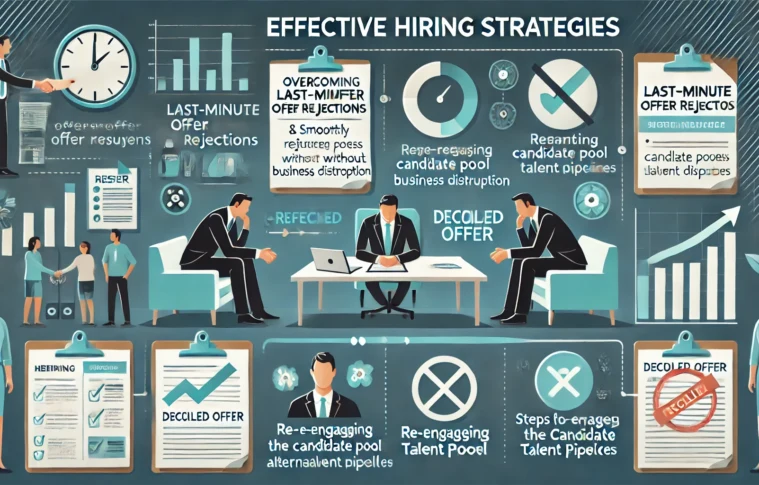In today’s competitive job market, hiring the right talent is a complex process that involves more than finding the ideal candidate. Companies must navigate the challenge of ensuring the candidate follows through on their commitment. A sudden last-minute offer rejection can set back project timelines, impact team morale, and even strain business relationships. Here’s how businesses can address and recover from these unexpected hiring setbacks effectively, ensuring minimal impact on ongoing deals.
1. Understanding Effective Hiring Processes
To secure top talent, hiring processes should be designed to:
- Engage Candidates Early: Build a relationship that allows you to gauge commitment throughout the hiring stages.
- Set Transparent Expectations: Outline responsibilities, cultural fit, and growth prospects clearly to ensure alignment from day one.
- Implement a Thorough Screening Process: Vet candidates through behavioral and situational questions, skills assessments, and culture-fit evaluations.
An efficient hiring process includes detailed job descriptions, a robust screening mechanism, and active communication, making it easier to identify red flags in commitment or fit early in the process.
2. Preventive Measures to Reduce Last-Minute Rejections
Though no process can entirely eliminate the risk of offer rejections, certain measures can minimize it:
- Conduct Candidate Background Checks: Investigate prior employment and ask specific questions to detect commitment tendencies.
- Keep Candidates Engaged: Send welcome emails, provide early access to resources, or invite them to introductory team meetings.
- Offer a Competitive Compensation Package: Offer more than just a competitive salary, such as development opportunities and flexible work options.
- Build Rapport Throughout the Process: A strong rapport keeps candidates emotionally invested in your offer. Regular check-ins and an open-door policy for any questions they may have about the role can reduce anxiety and last-minute withdrawals.
3. Handling a Last-Minute Rejection Effectively
Despite preventive measures, last-minute rejections can still occur. Here’s a strategic approach to mitigate the impact:
- Respond with Professionalism: A calm and professional response reflects positively on your company. Avoid any negative commentary, as it can damage employer branding.
- Inquire Respectfully: Understand the candidate’s reasons for declining; their feedback could highlight areas for improvement in your hiring process or compensation package.
- Leverage Your Candidate Pipeline: If you’ve maintained a candidate pool, this is the time to revisit it. Identify qualified candidates from previous rounds who were not initially offered the role but showed potential.
- Notify the Team Promptly: Addressing the team ensures everyone is aligned and can support the transition plan effectively.
4. Rebooting the Hiring Process Quickly
With business continuity on the line, swift action is essential. Here are steps to re-initiate hiring without slowing down business momentum:
- Reassess Job Requirements: Given the setback, re-evaluate if the position’s scope or requirements need adjusting based on team feedback or project demands.
- Consider Internal Talent First: Promote from within when possible. Internal candidates are already aligned with the company culture and can onboard faster.
- Engage Passive Candidates: Reaching out to passive candidates through LinkedIn or a job portal speeds up the hiring process, especially when they have relevant skills.
- Shorten the Screening Process for Known Talent: For candidates previously vetted, consider skipping initial stages or condensing the interview process without compromising quality.
5. Maintaining Business Continuity During the Hiring Gap
Here’s how to keep operations running smoothly even when a critical role is vacant:
- Redistribute Responsibilities Temporarily: Delegate essential tasks to other team members with experience in similar functions. Make sure workload adjustments are reasonable to avoid burnout.
- Use Freelancers or Contractors: Short-term hires like freelancers or contractors can fill the immediate gap and maintain project timelines.
- Automate Where Possible: Use automation tools for tasks that can be standardized, reducing the burden on team members.
- Communicate with Clients: If the hiring gap may impact deliverables, be upfront with clients about the situation and provide updated timelines or alternatives.
6. Learning from the Experience to Refine Future Hiring
Every setback is an opportunity for improvement. Conduct a postmortem of the situation to identify what could have been done differently:
- Identify Patterns of Candidate Drop-Offs: If last-minute rejections happen frequently, analyze common patterns like salary mismatches or cultural fit issues to address these in future hiring rounds.
- Evaluate the Role of Candidate Engagement: Explore if you can enhance communication touchpoints or involve other team members to create a stronger commitment bond.
- Assess Job Offers and Onboarding Processes: Consider if offer letters and onboarding could be restructured to lock in commitment more securely.
7. Conclusion
Hiring is not a one-size-fits-all process, and adapting to changes and setbacks is a fundamental part of it. A well-rounded hiring strategy emphasizes proactive engagement, preventive steps to minimize drop-offs, and agility in dealing with sudden candidate withdrawals. By creating a resilient hiring pipeline and a strong candidate pool, businesses can turn potential disruptions into opportunities for refining their hiring process, ultimately strengthening their team with committed talent.
This approach will ensure your business is well-prepared to handle any surprises, all while staying focused on growth, stability, and delivering on your commitments.



